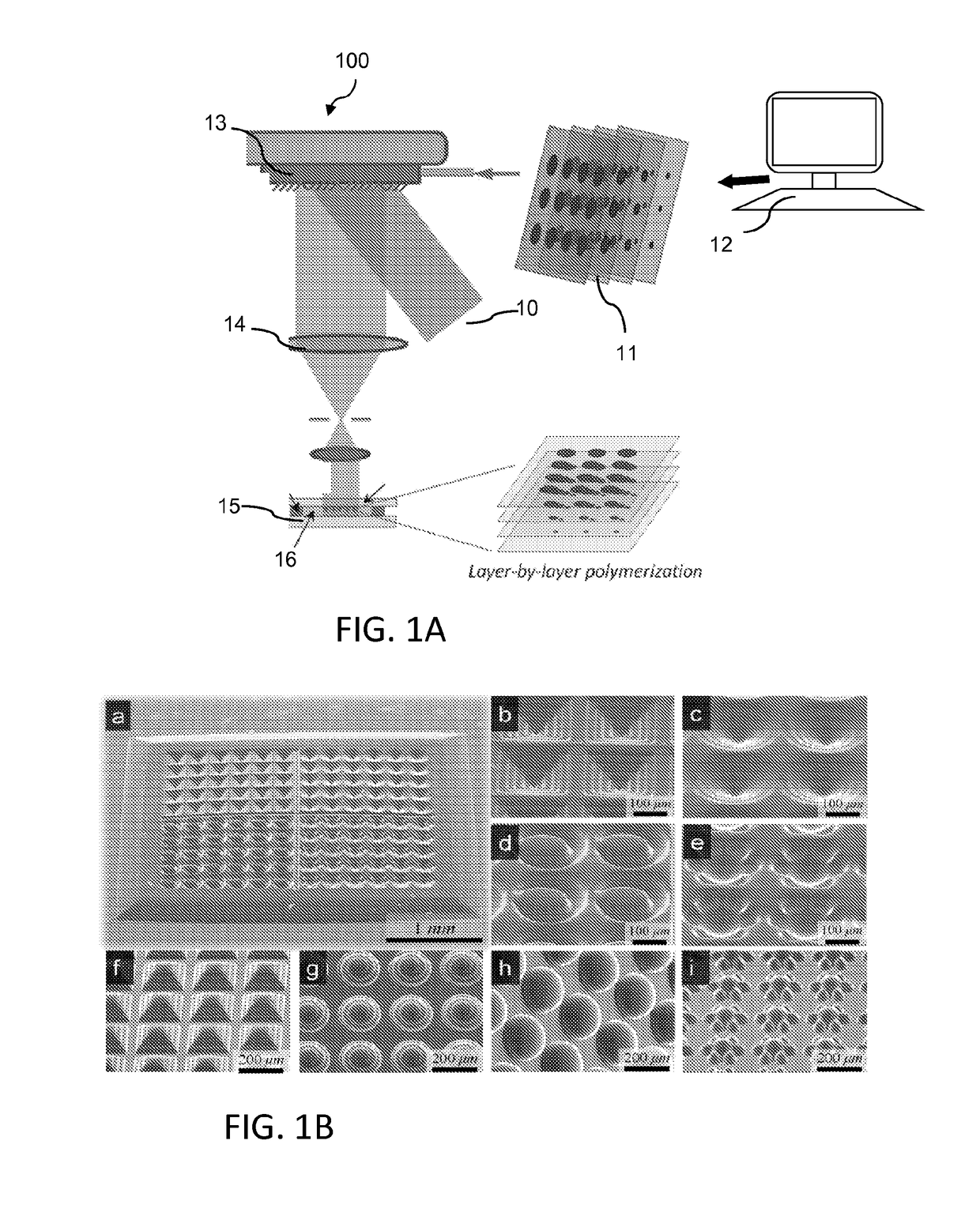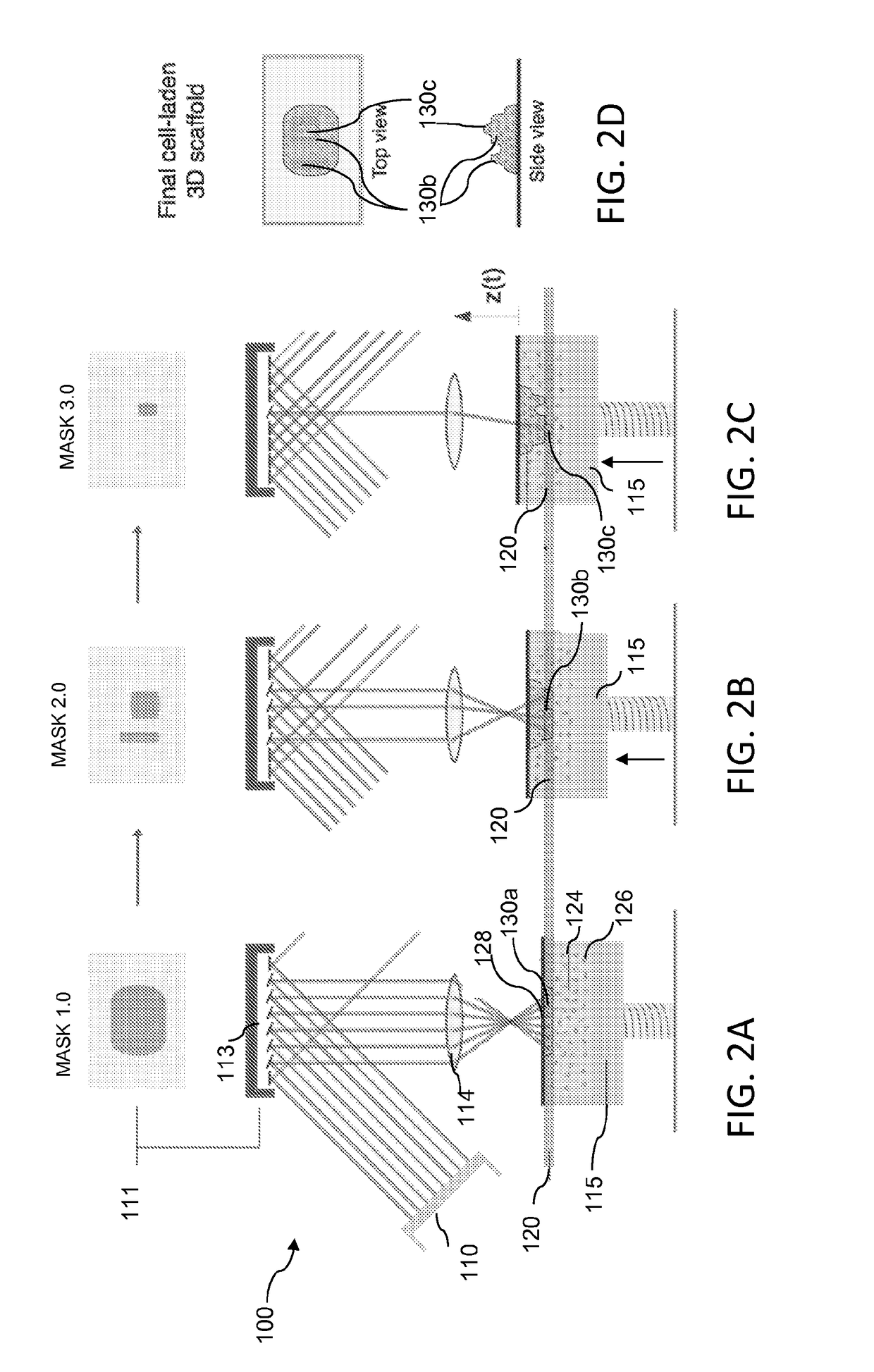Layerless bioprinting via dynamic optical projection and uses thereof
a bioprinting and optical projection technology, applied in the field of three-dimensional structure microfabrication, can solve the problems of inability to achieve speed and scalability well, and achieve the effects of high resolution, high resolution and rapid generation of polymeric scaffolds
- Summary
- Abstract
- Description
- Claims
- Application Information
AI Technical Summary
Benefits of technology
Problems solved by technology
Method used
Image
Examples
example 1
Brain-on-a-Chip
[0084]The L3PDOP platform described above yields two powerful modes of operation, which are diagrammatically illustrated in FIG. 7. The first modality 72 provides for 3D microscale bioprinting of biological substrates via dynamic stereolithography. The second modality 74 provides for optogenetic control of neurons with high spatiotemporal resolution. Stereolithographic 3D bioprinting (mode 72) using the printing platform described with reference to FIG. 1A and FIGS. 2A-2C provides for photopolymerization of multiple biocompatible materials (e.g., PEGDA, MeHA, GelMA) and facilitates cell encapsulation within these structures. Additionally, these materials—along with their incorporated cell types—can be used heterogeneously in the same scaffold to provide 3D patterned co-culture substrates, thus facilitating the study of neuronal / glial interactions.
[0085]Importantly, the inventive platform is capable of functioning not only in the fabrication and optogenetic stimulation...
example 2
Neural Clusters from iPSCs
[0088]The inventive L3PDOP platform finds myriad applications in fundamental neuroscience research, clinical diagnostics, screening of novel drug candidates, and comparative investigations of artificial versus biological neural networks in conjunction with neuromorphic hardware (e.g. “brain-on-a-chip” devices). The inventive printing technique enables facile, rapid fabrication of 3D hydrogels that support the culture of iPSC-derived neurons with the following capabilities: 1) 3D patterning of hydrogel microenvironments via dynamic optical stereolithography for high-throughput scaffold fabrication that is co-registered with MEAs at high precision; 2) directed arrangement of neural clusters and modulation of cell alignment, growth, and connectivity via hydrogel composition, geometry, and dimensions; 3) support for functional connectivity as demonstrated by positive expression of associated biomolecular markers, and 4) spontaneous electrical activity during lo...
example 3
Integration with 3D-Printed Conductive Polymer Electrodes
[0094]High-density 3D recording of the neural network can be achieved by using the stereolithographic technique presented herein to incorporate biocompatible conductive polymers, such as PANI-PAAMPSA, at precise spatial arrangements to transmit neural electrical signals to the multi-electrode array (MEA) substrate. FIGS. 21A and 21B illustrate one possible spatial arrangement and varying electrode lengths, respectively. FIG. 21A shows a simple grid-like array in MEA 210, with uniformly spaced rows and columns of flat electrodes of similar heights, while FIG. 21B illustrates electrodes 212A-n of different lengths (heights) extending from the same grid. As will be readily apparent to those in the art, different geometrical layouts and varying electrode heights can be constructed by selection of appropriate printing patterns, conditions, and materials. Compared to conventional flat electrodes on MEAs, which can directly access on...
PUM
| Property | Measurement | Unit |
|---|---|---|
| strain rate | aaaaa | aaaaa |
| depths | aaaaa | aaaaa |
| depths | aaaaa | aaaaa |
Abstract
Description
Claims
Application Information
 Login to View More
Login to View More - R&D
- Intellectual Property
- Life Sciences
- Materials
- Tech Scout
- Unparalleled Data Quality
- Higher Quality Content
- 60% Fewer Hallucinations
Browse by: Latest US Patents, China's latest patents, Technical Efficacy Thesaurus, Application Domain, Technology Topic, Popular Technical Reports.
© 2025 PatSnap. All rights reserved.Legal|Privacy policy|Modern Slavery Act Transparency Statement|Sitemap|About US| Contact US: help@patsnap.com



